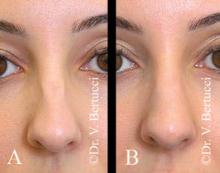CHICAGO - Some patients are ideal candidates for nonsurgical rhinoplasty to reshape the nose, according to experts.
Patients unready or unwilling to undergo surgery, for example, could opt for more temporary aesthetic changes through injectable products, two presenters noted at the annual meeting of the American Society for Dermatologic Surgery.
Unlike more familiar facial cosmetic procedures, patients might need to be educated that injectables in the nose are a valid option, said Dr. Jean-François Tremblay, chief of the dermatologic surgery unit at the University of Montreal’s hospital center. Some will also need guidance as to what constitutes an ideal nose.
"We are not going to replace rhinoplasty, but there is a lot we can do with fillers in an in-and-out procedure," said Dr. Vince Bertucci, Immediate Past President of the Canadian Society for Dermatologic Surgery and the Medical Director of Bertucci MedSpa in Woodbridge, just outside Toronto.
Fillers can increase nasal tip projection and give the nose a longer, more refined appearance. Botulinum toxin can reduce dynamic changes that occur for some during facial expression, such as tip movement, "bunny lines," or alar flare. "Some patients with bunny lines really pull up their ali when they smile, but post botulinum toxin injection, they do not raise up as high," Dr. Bertucci said.
In some cases, fillers and botulinum toxin can be used in combination. Nasal tip droop is a common concern, Dr. Bertucci said. Botulinum toxin injected into the depressor septi nasi at the base of the columella can reverse this common effect of aging. He cautioned, however, the upper lip can be widened or elongated with this technique, and the upper lip tends to be already elongated in some elderly patients.
Dr. Bertucci emphasized the importance of knowing the nasal anatomy and danger zones. For example, inject botulinum toxin approximately half way between the nasal-facial junction and dorsum of the nose to avoid hitting the muscle that lifts the mouth. If the levator labii superioris alaeque nasi is inadvertently treated, the patient may end up with an unusual or asymmetric smile. "The message here is do not inject too far down the side of the nose."
The best candidates for nonsurgical rhinoplasty have minor deformities, not major deviations or bony anomalies, Dr. Tremblay said. Lower cost, little to no downtime, and the reversible or modifiable nature of the filler correction are among the appeals, he said. A temporary duration of effect can be a disadvantage. In addition, "we can only add volume and not remove anything," said Dr. Tremblay during the joint presentation.
An important caveat is patients who seek correction with injectables after a rhinoplasty require additional caution and expertise. "I would not recommend starting out on post-rhinoplasty patients," Dr. Bertucci said. Vascular changes and modification of bone and tissue from surgery can increase the risk of necrosis.
Regardless of history, begin by asking all patients what bothers them, Dr. Tremblay advised. "I want to understand their expectations, what their notion of an ideal nose is, and do a quick psychoanalysis 101." He added, "The rate of people having body dysmorphic disorder is higher when people complain about their noses versus other concerns. So it could be a sign someone does not have balanced psychological health."
Ensure you view the nose from all angles (frontal, lateral, and basal) and consider any aesthetic changes in the context of the entire face. "The basal view can show underlying anomalies that might explain superficial features we are trying to correct," Dr. Tremblay said.
An ideal nose "cannot be defined for any given individual without taking into consideration the rest of the facial features," Dr. Tremblay said. For example, he increased the chin projection of a woman who initially wanted the size of her nose reduced. She was happy with her nose after the chin augmentation.
Skin thickness varies in different parts of the nose. In general, the mid-nose skin tends to be thinner and more delicate than the proximal and distal areas. "So when you inject the mid-nose, keep in mind the need to [massage] material around so you don’t get a prominence," Dr. Bertucci said. Also avoid superficial placement and overcorrection with fillers (consider a staged correction). He added, "Injecting slowly is really important. It seems like a simple thing, but look at the skin as you inject is it blanching?"



